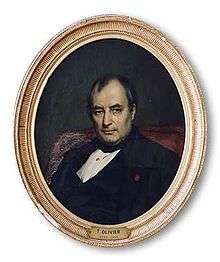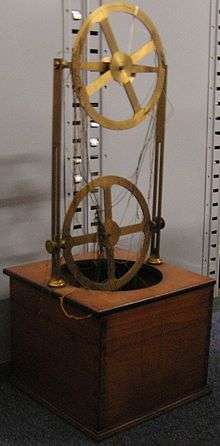Théodore Olivier
| Théodore Olivier | |
|---|---|
 | |
| Born |
January 14, 1793 Lyon, France |
| Died |
August 5, 1853 (aged 60) Lyon, France |
| Resting place |
Montparnasse Cemetery 48°50′17″N 2°19′37″E / 48.83806°N 2.32694°E |
| Alma mater | École Polytechnique |
| Scientific career | |
| Fields | Mathematics |
| Institutions | Ecole centrale des arts et manufactures |
| Influences | Gaspard Monge |
Théodore Olivier (1793–1853) was a French mathematician.
Life and work
Olivier studied in the Licée Imperial of Lyon where he obtained in 1811 a degree in mathematics with high honours. After this, he went to the École Polytechnique.[1] Olivier looked like Napoleon, but nobody could prove that Olivier was an illegitimate son of the Emperor.[2]
In 1815, he was an adjunct professor in the Artillery School at Metz and, in 1819, he became a full professor. In 1821, at the request of the King of Sweden, Charles XIV John (Jean-Baptiste Bernadotte), he went to Sweden to organize the military school of Mariemberg.[3]
Returning to France, Oliver criticized the pedagogical system in the École Polytechnique and in 1829, jointly with Alphonse Lavallée, Jean-Baptiste Dumas and Jean Claude Eugène Péclet, founded the École Centrale des Arts et Manufactures, where he was professor of geometry and mechanics for the rest of his life.[4] He also was, between 1830 and 1844, a professor at the École Polytechnique and, from 1838, a professor at the École Nationale Supérieure des Arts et Métiers.[5]

Olivier is mainly known for the construction of three-dimensional models of geometry for pedagogical purposes.[4] Most of them were sold to North American institutions such as Union College, the University of Columbia and West Point, where they are preserved.[6]
Olivier also studied the theory of gears, writing an extensive treatise on the subject, and constructing models, preserved in the Musée des Art et Offices in Paris.[7]
Olivier had no children, but he was the uncle of the French explorer Aimé Olivier de Sanderval.
References
Bibliography
- Hervé, J.M. (2007). "Théodore Olivier (1793–1853)". In Marco Ceccarelli (ed.). Distinguished Figures in Mechanism and Machine Science. Springer. pp. 294–319. ISBN 978-1-4020-6365-7.
- Jacomy, Bruno (1995). "Du cabinet au Conservatoire. Les instruments scientifiques du Conservatoire des Arts et Métiers à Paris". Journal of the History of Collections (in French). 7 (2): 227–233. doi:10.1093/jhc/7.2.227. ISSN 0954-6650.
- Nesme, Auguste (1858). Notice sur Théodore Olivier (in French). Aimé Vingtrinier.
External links
| Wikimedia Commons has media related to Théodore Olivier (mathematician). |
- O'Connor, John J.; Robertson, Edmund F., "Théodore Olivier", MacTutor History of Mathematics archive, University of St Andrews .
- Union College Permanent Collection, "Olivier Models".
- Union College (ed.). "The Olivier Models". Retrieved 19 June 2016.
- Canada Science and Technology Museum (ed.). "Theodore Olivier 3D Geometric Models". Retrieved 19 June 2016.